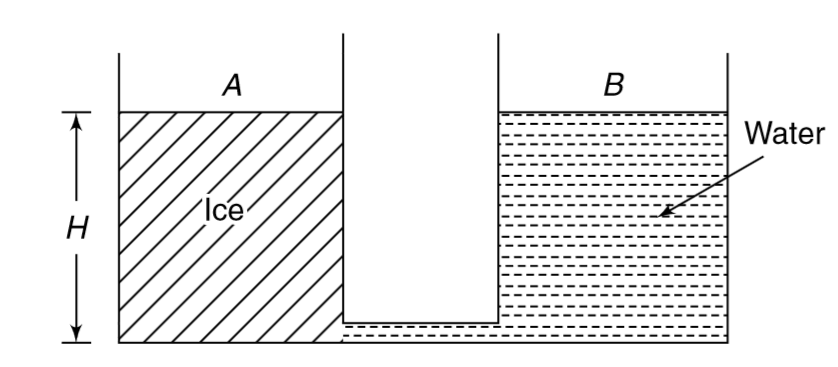Pramila studies anomalous behaiour of water using Hope's apparatus in the laboratory.

The water of 12∘C is filled in cylindrical container and experiment is conducted.
Why is the mixture of ice and salt added into the flat bowl?
When salt is added to the ice. freezing point of ice decreases below 0∘C which helps cooling water in cylindrical container better.
Topper's Solved these Questions
- HEATBOOK - TARGET PUBLICATIONCHAPTER - HEATEXERCISE - Solve the following problems
22 Videos
- HEATBOOK - TARGET PUBLICATIONCHAPTER - HEATEXERCISE - Practice problems
20 Videos
- HEATBOOK - TARGET PUBLICATIONCHAPTER - HEATEXERCISE - Complete the given chart
2 Videos
- GRAVITATIONBOOK - TARGET PUBLICATIONCHAPTER - GRAVITATIONEXERCISE - ASSESSMENT
19 Videos
- LENSES BOOK - TARGET PUBLICATIONCHAPTER - LENSES EXERCISE - Chapter Assessment
21 Videos
Similar Questions
Knowledge Check
By studying anomalous behaviour of water using Hope's apparatus, it is concluded that
Apressure lowers melting point of ice.Bwater has maximum density at 4∘CCwater has maximum density at 4∘CDwater has maximum density at 0∘CBy studying anomalous behaviour of water using Hope's apparatus, it is concluded that
Apressure lowers melting point of ice.Bwater has maximum density at 4∘CCwater has maximum density at 4∘CDwater has maximum density at 0∘C
Given below are two quantities named I and II. Based on the given information, you have to determine the relation between the two quantities. You should use the given data and your knowledge of Mathematics to choose among the possible answers.
Quantity I: A 63 litres mixture of wine and water contains wine and water in the ratio 5: 4 respectively. A lady added another 49 litres mixture of wine and water which contains wine and water in the ratio 4: 3 respectively. Another lady added 12 litres of wine and 1 litres of water into the mixture. The final mixture is divided into three containers in the ratio 2: 2: 1 respectively. Find the difference between quantities of water in the first and third container.
Quantity II: Ratio of milk and water in a mixture is 13: 7 respectively. The milkman added 5 litres of milk and 15 litres of water to the mixture and hence the ratio becomes 7: 5 respectively. The milkman sold 50% of the new mixture and added 10 litres of milk and 8 litres of water to the remaining mixture. Find the difference between the quantities of milk and water in the final mixture.
View SolutionAbhinav is a student of class IX. One day all the students were performing experiments in the science laboratory. Just then, the chemistry teacher, Mrs. Prasad, came to the laboratory. She had three beaker in her hands labelled A, B and C. All the beakers contained colourless liquids which looked exactly the same. Mrs. Prasad turned to the students and said that one of the beakers contained a pure substance whereas the other two beakers contained solutions of the same solute in the same solvent but different concentrations. She also told the students that the weight one of the three beakers A, B and C were 110g, 120g and 100g respectively. Mrs. Prasad wanted one of the students to find out experiementally which beaker contained a pure substance and which two beakers contained solutions. She also wanted them to show experimentally two properties which could tell why the solutions are considered mixtures, even though they are homogeneous substances. Mrs. Prasad wanted one of the the students to find out experimentally which beaker contained a pure substance and which two beakers contained solutions. She also wanted them to show experimentally two properties which could tell why the solutions are considered mixtures, even though they are homogeneous substances. Mrs. Prasad allowed them to use any required apparatus from the laboratory for the purpose. Abhinav offered to perform the experiements to distinguish between the pure substance and solutions and also to show experimentally why solutions are considered mixtures.
(a) What did Abhinav do to find out which of the given liquids is a pure substances and which liquids are solutions ? What were the observations made by Abhinav ?
(b) Whay did Abhinav conclude form the above observations ?
(c) Which property of the pure substance is exhibited by this experiment ?
(d) Which properties of a solution are exhibited in this experiement ?
(e) What values are displayed by Abhinav in this episode ?
View SolutionDiscuss the temperature variations observed in two thermometers attached to cylindrical container in Hope's apparatus while studying anomalous behaviour of water.
View SolutionBy studying anomalous behaviour of water using Hope's apparatus, it is concluded that
View SolutionTwo identical cylindrical containers A and B are interconnected by a tube of negligible dimensions. Container A is filled with an ice block up to height H = 1.8 m and container B is filled up to same height with water. Ice is at 0∘C and water is at 40∘C. Due to heat exchange between water and ice, the ice block begins to melt. Assume that the ice block melt in horizontal layers starting from the bottom. The thickness of ice block reduces uniformly over the entire cross section of the container. The ice block moves without friction inside the container and no water enters between the vertical wall of the container and the ice block. Heat is exchanged only between the ice block and the water and there is no heat exchange with containers or atmosphere. Calculate the height of water in container B when thermal equilibrium is attained. Relative density and specific latent heat of fusion of ice are 0.9 and 80calg−1 respectively. Specific heat capacity of water is 1calg−1.∘C−1.

View SolutionA cylindrical copper rod of length 0.60m and cross-sectional area 6.0 cm2 is insulated along its side. The ends are held at a temperature difference of 100∘C by having one end in a water -ice mixture and the other in a mixture of boiling water and steam. At what reate (a) is energy conducted by the rod and (b) does the ice melt ?
View Solution
